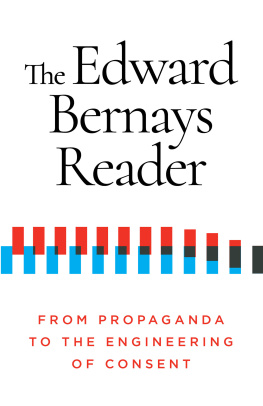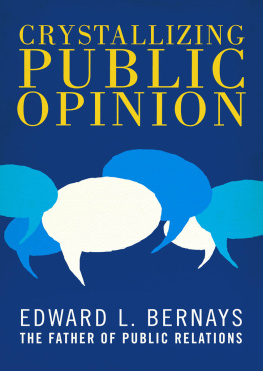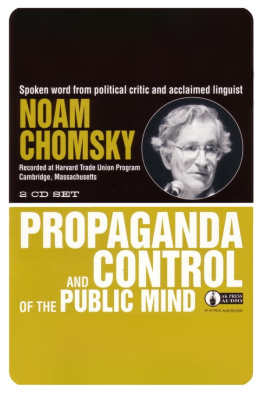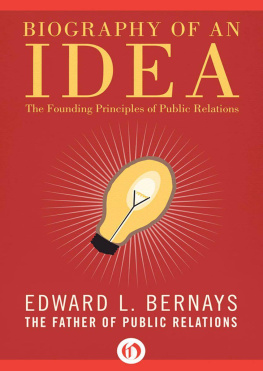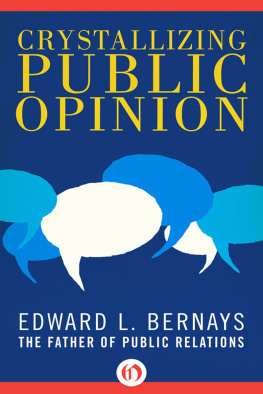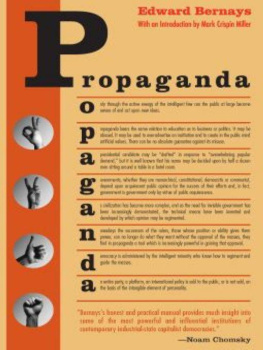Contents
Page List
Guide

THE Edward Bernays Reader
From Propaganda to The Engineering of Consent
INTRODUCTION BY NANCY SNOW

NEW YORK, NY
Introduction copyright 2021 by Nancy Snow.
All rights reserved.
See credits for a detailed list of permission acknowledgments.
No part of this book may be used or reproduced in any manner without written permission of the publisher. Please direct inquiries to:
Ig Publishing
Box 2547
New York, NY 10163
www.igpub.com
ISBN 978-163246-138-4
CONTENTS
by Nancy Snow
INTRODUCTION
THE MERRIAM-WEBSTER DICTIONARY DISTINGUISHES between two types of influencers. The first and original definition refers to a person who inspires or guides the actions of others. The twenty-first century meaning of an influencer more often than not refers to a person who is able to generate interest in something (such as a consumer product) by posting about it on social media. The first definition connotes exclusivity. Not everyone can be an influencer without proper training, education, and insight. The latter connotes inclusivity. Anyone can be a social media influencer with enough moxie and drive to become talked about or followed online.
Bernays was the ursprung influencer. There is no one who compares to him before or since he lived. His lifes work, the most influential of which is presented in this book, was astonishingly ahead of its time but also seamlessly applicable to todays media and propaganda environment.
The Viennese-born Edward Louis Bernays, double nephew of Sigmund Freud, would have heartily rejected the populist concept today that anyone can be an influencer. He believed in war and peacetime propaganda campaigns that served the interests of the ruling power classes against the unreliable, undisciplined, but malleable masses. Bernays would surely have been repelled by the lowest common denominator tendencies in todays social media platforms where often the most sensationalized images get the most likes. He was a man of letters who graduated from Cornell University, part of the elite Ivy League in his adopted country, the United States.
At first glance it might appear that his 1912 degree in agriculturehe initially aspired to work in his fathers grain export businesswas far adrift from his future profession in press agentry, journalism, and wartime propaganda. But indeed, the verb form of the noun propaganda has agricultural origins. To propagate is to cause an organism to be fruitful and multiply by process of reproduction from the parent stock, like a farmer seeding his growing field. In the case of Bernays, he was literally the parent stock of the discipline and industry we know today as public relations. His offspring were those ideas that took flight on behalf of his clients, the foremost being the United States government during World War I. In seven short years after his graduation and the wars end in 1919, he opened an office as Public Relations Counselor in New York City. Public Relations Counselor had a much better ring to it than Government Propagandist and so began Bernays seventy-year venture into building a client base and self-promoting his own reputation as the nations foremost persuader and creator of overt acts through covert means. He died in 1995 at age 103.
While Bernays is acknowledged as pioneering the field of public relationshes often referred to as its father or grandfatherhis influence is not discussed enough in scholarly circles. The modern public relations industry doesnt seem to quite know what to do with him or his legacy since he is forever associated with the pejorative term propaganda, a concept in the United States that is almost universally reviled as lies or what only ones worst enemy engages in. Students of PR do not think of themselves as corporate propagandists and avoid association with its ancillaries like spin doctoring and hucksterism. To its credit, the Museum of Public Relations in New York City acknowledges Bernays as a pioneer in the field.
Bernays openly embraced propaganda because he believed that it worked well, with his proper guidance and counsel, to support client opinions as the publics own interests. A man who published works such as Crystallizing Public Opinion (1923) and Propaganda (1928) is a man of self-assuredness about the impact of his public opinion management on peoples thinking and behavior. Its no surprise that another man of influence of Bernays era, Henry Luce, would identify Bernays in Life magazine as one of the 100 most influential Americans of the twentieth century. Both men would bookend the apex of influence in the American century.
Journalist Bill Moyers interviewed Bernays for his 1983 program, The Image Makers. The then nonagenarian Bernays told Moyers that his public relations counsel was a form of good propaganda (aka proper-ganda) and not improper-ganda. Woodrow Wilsons Committee on Public Information (Creel Committee), for which Bernays first worked, was a propaganda operation designed to persuade the masses at home and abroad that World War I would be the war to end all wars and would help to make the world safe for democracy. After the war, Bernays accompanied President Wilson as a press attach to the peace talks in Paris where he witnessed the emotional zeal that the Europeans placed on the great liberator, Wilson. When he returned to America, Bernays said, I decided that if you could use propaganda for war, you could certainly use it for peace.
In the Flapper 1920s, Bernays hung up his sign in service to private clients, giving public relations a commercial capitalist tinge. One of his first industry clients was the Beech-nut Company, which produced bacon. It wasnt enough to devise a plan to ask warfatigued consumers to eat more Beech-nut bacon product; Bernays wanted to be an indispensable PR counsel to the entire bacon producing industry. Just like he had during wartime with selling war for democracy, Bernays chose to associate bacon with something important in peacetime America, the ideal meat choice for the first big meal before fathers went off to work and children went off to school. Who better to shape that opinion than male doctors in white coats, who gave testimonials associating bacon with a hearty breakfast and as an excellent way to start ones day? Ordering an American-style breakfast anywhere in the world will, even today, almost always produce a plate of bacon and eggs.
American Tobacco Company president George W. Hill sought the counsel of Bernays to help him serve their growing female client base who had earned the right to vote in 1920. Unlike men, women who smoked could do so only in private as it was considered unladylike if she smoked while walking down the street. She might as well have been a street walker. Bernays chose to tear down the wall between the private and public by associating womens rights to vote with smoking. The annual Easter Parade in New York City offered an opportunity for Bernays to hire fashionable models, including his own secretary Bertha Hunt, to walk along taking drags on their torches of freedom. The undercover Hunt signed a telegram sent to a list of New Yorks finest debutantes: In the interests of equality of the sexes and to fight another sex taboo I and other young women will light another torch of freedom by smoking cigarettes while strolling on Fifth Avenue Easter Sunday. Bernays hired photographers to document his campaign. The front page of the Monday, April 1, 1929

